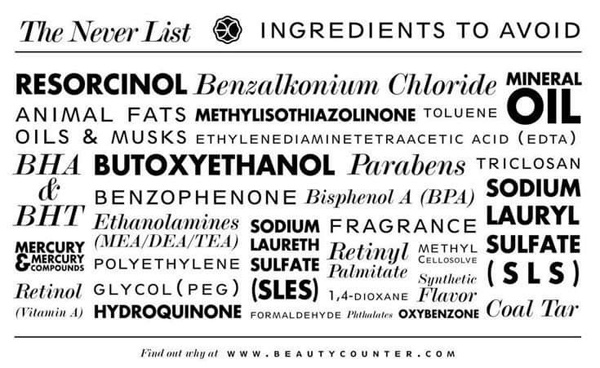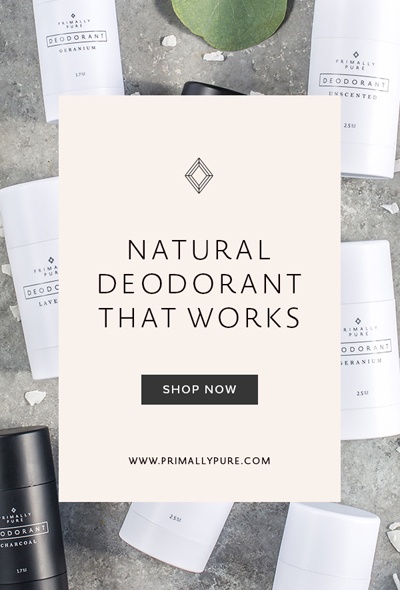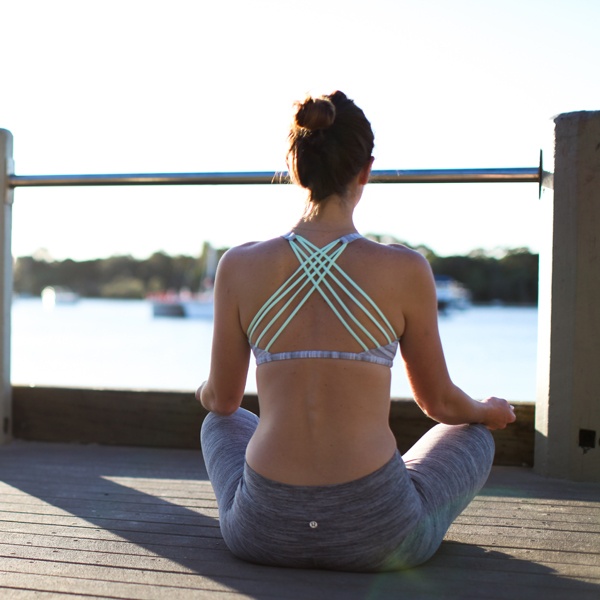Top 5 toxic skincare ingredients to avoid

Are your skincare products safe?
With summer in full swing, the hot temps and sunny days mean lots of sunscreen and multiple deodorant applications. Does anyone else feel like showering 10 minutes after showering this time of year? Since I can’t just live in the shower, I do what any sane person does on no-work days. I veer towards water. Most often, this means day trips to the swimming pool.
The other day, I looked around at the other parents. Like me, they were all periodically chasing down their littles to reapply sunscreen sprays and lotions. Of course, it was buggy out of the water (those tiny black gnats are the worst!), so some moms were applying bug spray, too. Sometimes doing outdoor things in the summer feels like so much work, you know? And when I tell you the following tidbit of information, you may wonder why we even bother.
Your products may not be what they seem.
Did you know that 8 of the most common sunscreen ingredients are linked to endocrine disruption? That’s super scary when you really think about it. The Environmental Working Group says the only consistently safe sunscreen ingredients are zinc oxide and titanium dioxide. But a quick glance at most bottles of sunscreen reflects a much lengthier list of ingredients than that. Many with the most harmful ones studied, like:
- Oxybenzone
- Octinoxate
- Octisalate
- Octocrylene
- Homosalate
- Avobenzone
The problem is deeper than sunscreen, though, my friends.
Anything we put on our skin ends up inside our bodies.
That day at the pool made me think hard about the products many of us use daily. We use so many products aside from the sunscreens and bug sprays in the summer. There are lotions, shampoos and conditioners, makeup, body washes, skincare products, deodorants…the list is endless depending on the time of year and our personal habits.
Try not to freak out—as I did after learning this shortly after having thyroid cancer, and scour your entire home of products with toxic ingredients. Then, as you use products up, review them to see if you should consider switching to a safer option that gets you similar results from using it.
Many people forget that our skin, the largest organ of the human body, absorbs so much. A Google search shows hundreds of articles that say the same thing—60 to 70% of what we put on our skin gets into our bodies. That’s a whole new level to the term “we are what we eat,” right?
My guess is you’ve heard some element of this information before. We get so busy, though, that it’s hard to keep track of all the toxic chemicals we’re supposed to steer clear of. Nevertheless, there are simple steps you can do to be aware of and hopefully avoid the harmful ingredients that seem to lurk everywhere.

Don’t get sucked into the “green sheen” of marketing tricks.
Marketing teams know what’s important to consumers. So even if their products don’t stand up as genuinely all-natural or good for skin, they know how to spin it. They slap on the pretty packaging and a few bait words, and voila! Consumers buy something thinking it’s a healthier and more eco-friendly alternative.
But you have to be careful not to fall prey to the green sheen of the all-natural claims. This means not taking the esthetically pleasing packaging at face value. I’m a sucker for the beautiful bottles of skin creams and oils, so I’ve had to learn to look beyond the attention-grabbing words and pictures on the front. A product will list all the things you need to know on the back label, just like packaged foods.
- Read the ingredients list: Even if the front of the bottle says the product is free of parabens and non-toxic, look closely at the ingredients. If you don’t recognize the lengthy scientific names, chances are there are some hidden synthetic ingredients linked to hormonal disruptions.
- Look for a third-party certification or seal: Because the FDA doesn’t regulate beauty and personal care products, companies can make any eco-friendly, non-toxic, and natural claims they want. EcoCert and EWG Verified are two examples of seals on packaging where you can breathe easy knowing your product has been third-party tested and is what it says it is. Also, if you type in the ingredient to your phone search, you’ll quickly get a response at the top if Europe has banned the ingredient – they are way ahead of the U.S. in this area.
Get to know the primary culprits.
In the hustle-and-bustle lives most of us lead, it’s unrealistic to stand in an aisle at Target analyzing every product against Google before we buy it. It’s also nearly impossible to memorize all the toxic ingredients to avoid. And obviously, some are much worse than others. That’s why it’s a good idea to know the top 5 worst ingredients and avoid them.
Phthalates
If you’re only interested in cutting out the worst of the worst, get to know the pseudonyms of phthalates. Any product with DEP, DBP, DEHP, or fragrance contains phthalates. It’s used as a binding agent in anything from shampoo to vinyl flooring. Although the FDA claims cosmetic use of phthalates is acceptable for human health, studies show phthalates are linked to reproductive disorders, various types of cancers, and endocrine disruptions. Refresher from school science: the endocrine system regulates our organs and allows us to function.
Hormones issues, anyone? You could be experiencing an endocrine system disruption. More recent studies have even linked phthalates to ADHD, asthma, and neurological disorders as if that weren’t bad enough.
Parabens
Parabens are preservatives used to keep fungus and mold at bay in personal care products like shampoos and conditioners, face lotions, sunscreens, and even toothpaste. They used to be in almost everything with higher water content. While the need for them is understandable, research has found that long-term use may be linked to chronic skin irritations, estrogen disruptions (which can cause reproductive issues), and cancers. Fortunately, many companies are nixing parabens, especially long-chain parabens, from their ingredients and using safer alternatives to ward off potential bacterial growth in products.
What are long-chain parabens? Chemistry wasn’t my specialty in school, and reading up on some of this sends my mind spiraling. But in most basic terms, the longer the alkyl chains in a paraben, the more toxic and potentially dangerous it is. You can recognize parabens on a product label by words that end in -paraben and -zoate.
Here are a few parabens you may see on the back of beauty products:
- Methylparaben – this may also show up as 4-hydroxy methyl ester benzoic acid or methyl 4-hydroxybenzoate
- Propylparaben
- Isopropylparaben
- Butylparaben
- Isobutylparaben
- Ethylparaben – this one sometimes shows up as parahydroxybenzoate
- Benzylparaben
Formaldehyde
You mostly hear about formaldehyde in nail polish (and at funeral homes), but it still sneaks into some beauty products. Formaldehyde is a gas used to preserve products but is linked to some pretty gnarly forms of cancer when inhaled. It’s rare to find the word formaldehyde in the ingredient label of personal care products other than nail polish. Still, some manufacturers are sneaky about adding formaldehyde-releasing agents into products. Watch for releasers like:
- DMDM hydantoin
- methylene glycol
- quaternium 15
- 3 dioxane
Fragrance
I briefly mentioned fragrance or its fancier name – parfum – under phthalates earlier. Unless added directly from a pure essential oil, fragrances are typically synthetic aromas created to linger for as long as possible. They are usually made with phthalates. That alone should send warning signals.
Most of us have grown up believing we have to smell like fruit, flowers, or other musky concoctions. I remember back when Bath and Bodyworks was the epitome of smelling good, I was often complimented on my Pearberry scent. And I loved knowing it was kind of my (and every other girl in the 90s) trademark scent. But what I didn’t realize at the time was the fruity scent was compounded by like 400 different chemicals. That I happily rubbed and spritzed on my skin all day long. I likely even used the shower gel. Yikes!
Smelling good isn’t wrong. In fact, I still like a slight fragrance when I’m dressing up for date night or a special occasion. I am just more mindful of the type of fragrance I put on my skin and more likely to use a naturally scented lotion than my old go-to, Pearberry. Did you know a product listing the ingredient fragrance could be made up of any mix of 5000 chemicals? You literally have no idea what you’re putting on your skin with fancy parfums. Not a risk I’m willing to take.
Aluminum
Commonly known fact: people sweat. And some people attempt to fight sweat with antiperspirant, an aluminum-based product, which actually controls the amount of sweating they do. Here’s the thing, though – our bodies are supposed to sweat. Sweat regulates our body temperature when we’re sweltering or overexerting ourselves. If you are new around here, I’m a sweater. This is something I’ve finally come to terms after trying every antiperspirant under the sun. We need to sweat to stay healthy!
And aluminum chlorohydrate, the main ingredient in antiperspirants, blocks our pores and stops us from sweating. That doesn’t even sound healthy, does it? Not only are we preventing our body from doing what it’s made to do, but aluminum is linked to a higher risk for breast cancer, kidney disease, and Alzheimer’s disease.
A healthy alternative to aluminum-based antiperspirant is deodorant. Deodorant doesn’t stop you from sweating, but it neutralizes the smell of body odor. I really like Primally Pure’s charcoal deodorant (and trust it enough to let my daughter use it). It keeps my scent fresh even on the muggiest of days. Try it for 10% off using my code Dawn10.

Find trustworthy brands.
There are many harmful chemicals out there that beauty care and cosmetic companies put into their products. While no one person can be completely aware of everything toxic on the market, it’s helpful to find a brand you trust and can stick with for your personal care needs. Fortunately, there’s an increasing awareness around the impact of phthalates, parabens, and all the other toxins commonly used. This just means more brands are trying to do their part in eliminating the potentially harmful ingredients from their products.
Primally Pure has become a brand that I trust. I’ve been using it for years and have loved everything I’ve tried. I’ve researched the crap out of a ton of products, and so far, Primally Pure hits all the marks for my and my family’s skincare needs.
A few other brands I trust their products to put on my skin are:
- J.R. Watkins – soaps & lotions
- Eminence – skincare
- BeautyCounter – skincare and makeup
Keep seeking knowledge.
Research is your friend. Don’t take personal care products at surface value and just assume companies have your best interest in mind. Instead, understand what’s in your lotions, sunscreens, makeup, and even the things we wash off right away, like shampoo and conditioner. What we put on our bodies can have a long-term effect on our health. And our handy dandy, ever-at-our-side smartphones can find us info in minutes. So if you don’t recognize an ingredient, give it a Google.
EWG’s Skin Deep is an excellent resource for knowing where products rank in safety. The database is updated frequently as more research is done on products. It ranks everything on a safety scale of 0-10, giving the products with 0-1 an EWG verification. Of course, this doesn’t mean I only use products that are EWG verified. But this database helps me know where my products stand at a glance and encourages me to do my own research.

By Category
Don't Miss Out!
Sign up to get Mental Edits delivered to your inbox
Primally Pure
Recently on the

blog
My Awakening Journey could be an Inspiration for You!!
Why is it Important to Read Food Labels Before Buying Them?
Chiropractor Care for Gut Health
Soak in more memories during mealtime
Snag My Meal Planner Sanity Saver
Expand your time & your sanity with your family using a simple guide to plan out your meals. Using my foolproof steps to guide you through writing out a weekly menu building in meals that fuels you and your family, reduce your weeknight stress, and build a grocery list within minutes. Check, check!




